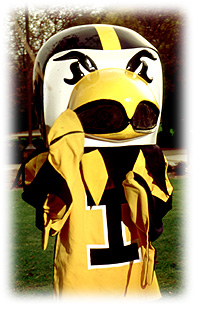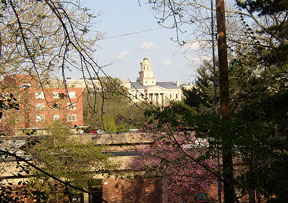From Big Ten to Ivy League: a passage between two institutions with much in common
By Susan S. Lang

Both Hunter Rawlings and David Skorton hail from the University of Iowa -- known as the Hawkeyes in the athletic arena. And yet the transition from the Big Ten to the Ivy League is one between two institutions that on many accounts are surprisingly similar.
The two universities share much more than having two men who both served as president at the University of Iowa before becoming presidents of Cornell. Both are major national research institutions comprising multiple colleges (Iowa has 11, Cornell 14) and with about the same number of academic disciplines (about 100).
"Cornell is an elite Ivy League private university with a very public land-grant mission," said Rawlings. "And that makes the Big Ten a natural place from which to draw leaders."
Both universities have deep and abiding commitments to teaching, research and outreach, a College of Arts and Sciences as well as business, engineering, law and medical schools with advanced and comprehensive university-owned teaching hospitals. Both schools also have very active and competitive athletic programs with varsity sports teams in Division I classes, and both have been chosen by the Princeton Review as one of the best schools in their regions.
Of course, the two schools have marked differences as well. Cornell's entire student population in Ithaca (undergraduate and graduate) is about 20,000 -- the size of Iowa's undergraduate population (Iowa enrolls another 9,500 graduate and professional students). And while Iowa's mascot is Herky the Hawk and its colors are black and gold, Cornell's mascot is the Big Red Bear and its colors are carnelian red and white.

The two schools, founded just 18 years apart, share similar pride in their historical heritage: the University of Iowa opened in 1847 and was the first U.S. public university to admit men and women on an equal basis; Cornell in 1865 became what has been called the first "American" university, open to "any person" of talent, regardless of gender, religion, ethnicity or socio-economic status.
Having spent the past 25 years in Iowa City, Skorton might well find himself at home in Ithaca, a town not all that different. Although Iowa City itself is significantly larger (and one of the largest cities in its state), both towns have the same area population of 100,000 people. And both Iowa City and Ithaca -- located just 1 degree latitude apart -- not only enjoy the full four seasons but also have about the same annual rainfall of 34-35 inches and average winter temperature of 22-24 degrees Fahrenheit, although Ithaca enjoys (or laments, depending on your outlook) more than twice as much snow (67 inches vs. 30 inches) than Iowa City. At about 100 feet higher in sea level than Iowa City (810 feet vs. almost 700 feet), Ithaca has cooler summers by about 4 degrees (average of 69 degrees in Ithaca vs. 73 in Iowa City).
With their excellent public schools, close, safe and comfortable neighborhoods and highly educated population, however, both cities rank high on "best-places-to-live" listings in national magazines. With state parks, plenty of countryside and either the Iowa River (which flows through the campus) or Cayuga Lake nearby, both cities have plenty of recreational opportunities for walking, hiking, biking and boating.
On the presidential level, the schools are also bonded by the fact that Charles A. Schaeffer, Iowa's seventh president (1887-1898), married Evelyn Schuyler of Ithaca in 1871.
Curiously, in other comparisons of the two universities, many statistics about one are double that of the other. For example, Cornell's number of faculty (2,627), percent of international students (15 percent), operating budget ($2.4 billion), number of major buildings (260) and bound-volume library holdings (7.5 million) are all about double that of Iowa's, with its 1,200 faculty, 7 percent international students, $1.2 billion operating budget, 125 major buildings and 4 million bound volumes.
Cornell also has the dubious distinction of charging about twice the tuition and fees ($31,300 for endowed and $30,200 for out-of-state enrollees in the contract colleges vs. Iowa's $17,000 for nonresidents) and having about half as many clear, sunny days as Iowa City.
Last but not least, while muscled men on mats (Sports Illustrated named the Iowa wrestling program one of the top sports dynasties of the 20th century) and on the football field steal the hearts and minds of the Hawkeyes, it is the icemen of Lynah Rink that capture the athletic pride and passion of the Big Red.
Media Contact
Get Cornell news delivered right to your inbox.
Subscribe